 |
 |
 |
| |
Vertex QUAD Therapy Yielded 83-93% SVR with 12 weeks duration of therapy: VX-222/TELAPREVIR IN COMBINATION WITH PEGINTERFERON-ALFA-2A AND RIBAVIRIN IN TREATMENT-NAï
VE GENOTYPE 1 HCV PATIENTS TREATED FOR 12 WEEKS: ZENITH STUDY, SVR12 INTERIM ANALYSIS
|
| |
| |
Reported by Jules Levin
Presented at the 22nd Conference of the Asian Pacific Association for the Study of the Liver (APASL), Taipei, Taiwan, February 16-19, 2012
Edward J Gane1*, Adrian M Di Bisceglie2, Mark S Sulkowski3, Ira M Jacobson4, Katia Alves5, Margaret J Koziel5, Cynthia DeSouza5, Tara L Kieffer5, Robert S Kauffman5, David R Nelson6
1Auckland City Hospital, Auckland, Auckland, New Zealand; 2Saint Louis University School of Medicine, Saint Louis, MO, USA; 3Johns Hopkins University, Baltimore, MD, USA; 4Weill Cornell Medical College, New York, NY, USA; 5Vertex Pharmaceuticals Incorporated, Cambridge, MA, USA; 6University of Florida College of Medicine, Gainesville, FL, USA
from Jules: --One patient relapsed got only 1 week of treatment so essentially 12 weeks of QUAD yielded 100% SVR.
"After the administration of study drugs for 12 weeks, patients with undetectable HCV RNA levels at Week 2 and Week 8 were eligible to stop their assigned treatment at Week 12, while patients with detectable HCV RNA levels at Week 2 and/or Week 8 received an additional 12 weeks of PR (for a total of 24 weeks)."
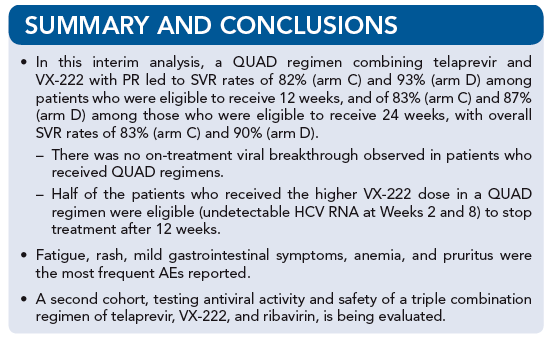
Introduction
VX-222 is a selective, noncompetitive inhibitor of the hepatitis C virus (HCV) NS5B polymerase.1 Telaprevir (TVR) is a specific, reversible, covalent, tight- and slow-binding HCV NS3/4A protease inhibitor2,3 that in combination with peginterferon and ribavirin (PR) improved sustained viral response (SVR) rates compared with PR.4-9
The combination of 2 direct-acting antiviral (DAA) compounds, such as VX-222 and TVR should:
- inhibit 2 different, essential enzymes for viral replication
- increase the barrier to resistance compared with each inhibitor alone
- increase the antiviral potency of the treatment regimen, additively or synergistically.
The ZENITH study is investigating the safety, tolerability, pharmacokinetics, and antiviral activity of combination treatment with 2 dose levels of VX-222 and a fixed dose of TVR administered with and without peginterferon alfa-2a and/or ribavirin for 12 to 24 weeks in treatment-naï
ve patients with genotype 1 chronic hepatitis C infection.
The results of the interim analysis of virologic data of all patients from arms C and D through Week 36, and safety and tolerability summary during the QUAD (TVR + VX-222 + Peg-IFN + RBV) phase (12 weeks of treatment) are presented here.

In Cohort 1: 106 patients were randomized (1:1:1:1) to 1 of 4 parallel treatment arms (A to D). Randomization was stratified by genotype 1a/unknown versus genotype 1b. 100 mg (A,C) and 400 mg (B,D) of VX-222 in combination with 1125 mg of TVR bid were evaluated with (C,D) and without (A,B) PR (180 μg/week peginterferon alfa-2a and 1000 mg/day or 1200 mg/day weight-based ribavirin). Arms A and B were discontinued early and results were presented elsewhere.10
After the administration of study drugs for 12 weeks, patients with undetectable HCV RNA levels at Week 2 and Week 8 were eligible to stop their assigned treatment at Week 12, while patients with detectable HCV RNA levels at Week 2 and/or Week 8 received an additional 12 weeks of PR (for a total of 24 weeks).
In Cohort 2: 23 patients each were assigned to arms E (genotype 1b) and F (genotype 1a) sequentially, in order to receive an interferon-sparing regimen composed of 400 mg of VX-222 in combination with 1125 mg of TVR bid and 1000 mg/day or 1200 mg/day weight-based ribavirin. Enrollment for both arms is complete.
Extension Phase
During the Investigational Phase, patients who had a viral breakthrough, viral relapse, or prematurely discontinued treatment with confirmed detectable HCV RNA levels (above the lower limit of quantification [LLOQ] of the assay) had the option to enter the Extension Phase and receive PR for 48 weeks.
Patient Population
Treatment-naï
ve patients with chronic genotype 1 hepatitis C were enrolled at 20 centers in the USA and New Zealand.
Key eligibility criteria:
- Aged 18-65 years
- Plasma HCV RNA >5 log10 IU/mL
- HBsAg, HIV-1, and HIV-2 seronegative
- Males, and females of non-childbearing potential
- Evidence of fibrosis by liver biopsy within 2 years of first dose of study drug
Patients with histologic evidence of cirrhosis were excluded.
Antiviral Assessments
Plasma HCV RNA assessment by Roche COBAS® TaqMan® HCV test (version 2.0; Roche Molecular Systems Inc., Branchburg, N.J.): LLOQ: 25 IU/mL, LOD: 10 IU/mL; HCV RNA values lower than 25 IU/mL were reported as either less than 25 IU/mL detectable or undetectable.
HCV RNA levels were measured at pre-specified time points during QUAD and PR dosing and after end-of-treatment (EOT) in order to calculate SVR12 and SVR24.
Viral breakthrough was defined as:
- an on-treatment increase in HCV RNA levels of >1 log10 compared with the lowest recorded on-treatment value (nadir), or
- confirmed on-treatment detectable HCV RNA levels after previous undetectable HCV RNA levels.
Safety Assessments
Safety and tolerability were assessed by monitoring adverse events (AEs), vital signs, laboratory test abnormalities, and electrocardiograms.
Per protocol, arms A and B were discontinued since the breakthrough rate exceeded 25% (based on a 2-sided 90% confidence interval [CI]).
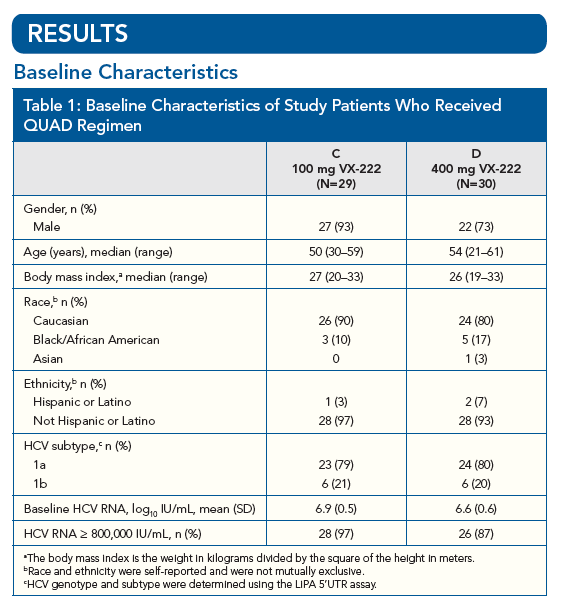
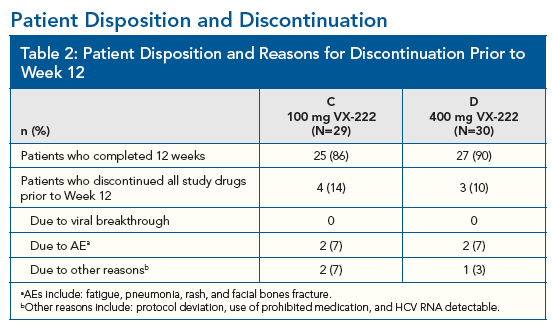
The median time to undetectable HCV RNA was 4 and 2 weeks in arms C and D, respectively.
Most patients achieved SVR (83% and 90% in arms C and D, respectively). No patient in either QUAD arm experienced viral breakthrough. However, 2 patients relapsed in arm C and 2 patients (including 1 patient who received only 1 week of treatment) in arm D.
More patients had undetectable HCV RNA at Weeks 2 and 8 in arm D than in arm C (50% vs 38%). These patients were eligible for 12-week treatment duration, and 82% (arm C) and 93% (arm D) of these patients achieved SVR.
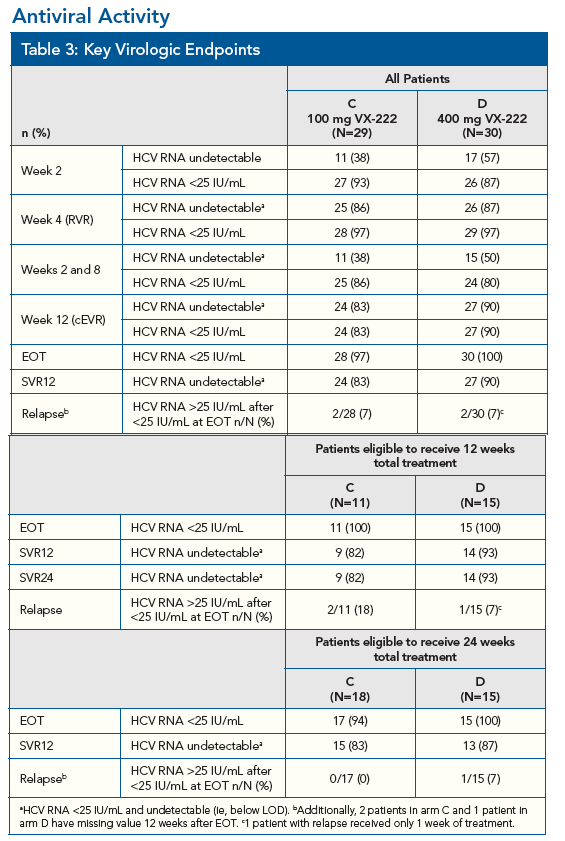
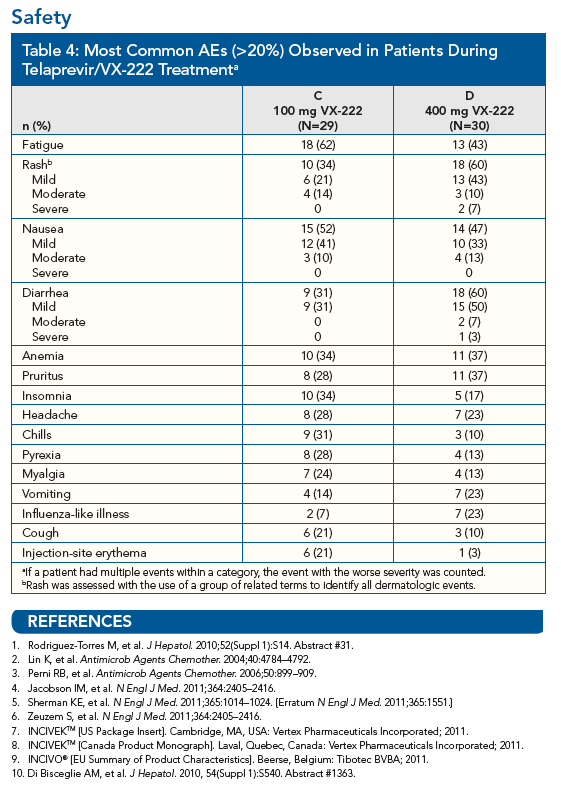
|
| |
|
 |
 |
|
|